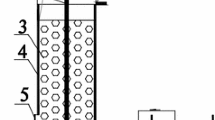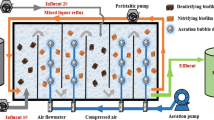Abstract
A three-dimensional biofilm-electrode reactor (3DBER) was integrated with sulfur autotrophic denitrification (SAD) to improve nitrogen removal performance for wastewater reclamation. The impacts of influent carbon/nitrogen (C/N) ratio, electric current, and hydraulic retention time (HRT) were evaluated. The new process, abbreviated as 3DBER-SAD, achieved a more stable denitrification compared to the recently studied 3DBER in literature. Its nitrogen removal improved by about 45 % as compared to 3DBER, especially under low C/N ratio conditions. The results also revealed that the biofilm bacteria community of 3DBER-SAD contained 21.1 % of the genus Thauera, 19.3 % of the genus Thiobacillus and Sulfuricella, as well as 5.3 % of the genus Alicycliphilus, Pseudomonas, and Paracoccus. The synergy between these heterotrophic, sulfur autotrophic, and hydrogenotrophic denitrification bacteria was believed to cause the high and stable nitrogen removal performance under various operating conditions.








Similar content being viewed by others
References
Capua FD, Papirio S, Lens PNL, Esposito G (2015) Chemolithotrophic denitrification in biofilm reactors. Chem Eng J 280:643–657
Hao RX, Li SM, Li JB, Meng CC (2013a) Denitrification of simulated municipal wastewater treatment plant effluent using a three-dimensional biofilm-electrode reactor: operating performance and bacterial community. Bioresour Technol 143:178–186
Hao RX, Li SM, Li JB, Zhang QK, Liu F (2013b) Water quality assessment for wastewater reclamation using principal component analysis. J Environ Inform 21:45–54
He Y, Wang Y, Song X (2016) High-effective denitrification of low C/N wastewater by combined constructed wetland and biofilm-electrode reactor (CW–BER). Bioresour Technol 203:245–251
Letain TE, Kane SR, Legler TC, Salazar EP, Agron PG, Beller HR (2007) Development of a genetic system for the chemolithoautotrophic bacterium Thiobacillus denitrificans. Appl. Environ. Microb. 73:3265–3271
Liu BB, Mao YJ, Bergaust L, Bakken LR, Frostegard A (2013) Strains in the genus Thauera exhibit remarkably different denitrification regulatory phenotypes. Environ Microbiol 15:2816–2828
Lu H, Chandran K, Stensel D (2014) Microbial ecology of denitrification in biological wastewater treatment. Water Res 64:237–254
Park HI, Kim JS, Kim DK, Choi YJ, Pak D (2005) Nitrate-reducing bacterial community in a biofilm-electrode reactor. Enzym Microb Technol 39:453–458
Pu J, Feng C, Liu Y, Li R, Kong Z, Chen N, Tong S, Hao C, Liu Y (2014) Pyrite-based autotrophic denitrification for remediation of nitrate contaminated groundwater. Bioresour Technol 173:117–123
Qiao N, Gao B, Zhang L, Chen R (2012) Factors affecting the denitrification property of heterotrophic nitrification-aerobic denitrifier. Fresenius Environ. Bull. 21:3773–3778
Rezania B, Cicek N, Oleszkiewicz JA (2005) Kinetics of hydrogen-dependent denitrification under varying pH and temperature conditions. Biotechnol Bioeng 92:900–906
Sahinkaya E, Kilic A (2014) Heterotrophic and elemental-sulfur-based autotrophic denitrification processes for simultaneous nitrate and Cr(VI) reduction. Water Res 50:278–286
Sahinkaya E, Kilic A, Duygulu B (2014) Pilot and full scale applications of sulfur-based autotrophic denitrification process for nitrate removal from activated sludge process effluent. Water Res 60:210–217
Shao M, Zhang T, Fang HH (2010) Sulfur-driven autotrophic denitrification: diversity, biochemistry, and engineering applications. Appl. Microbiol. Biotechnol. 88:1027–1042
Sun YM, Nemati M (2012) Evaluation of sulfur-based autotrophic denitrification and denitritation for biological removal of nitrate and nitrite from contaminated waters. Bioresour Technol 114:207–216
Tong S, Zhang B, Feng C, Zhao Y, Chen N, Hao C, Pu J, Zhao L (2013) Characteristics of heterotrophic/biofilm-electrode autotrophic denitrification for nitrate removal from groundwater. Bioresour Technol 148:121–127
Vasiliadou IA, Siozios S, Papadas IT, Bourtzis K, Pavlou S, Vayenas DV (2006) Kinetics of pure cultures of hydrogen-oxidizing denitrifying bacteria and modeling of the interactions among them in mixed cultures. Biotechnol Bioeng 95:513–525
Wan DJ, Liu HJ, Liu RP, Qu JH (2011) Study of a combined sulfur autotrophic with proton-exchange membrane electrodialytic denitrification technology: sulfate control and pH balance. Bioresour Technol 102:10803–10809
Wang HY, Qu JH (2003) Combined bioelectrochemical and sulfur autotrophic denitrification for drinking water treatment. Water Res 37:3767–3775
Watanabe T, Kojima H, Fukui M (2012) Draft genome sequence of a psychrotolerant sulfur-oxidizing bacterium, sulfuricella denitrificans skB26, and proteomic insights into cold adaptation. Appl Environ Microb 78:6545–6549
Wunderlich A, Meckenstock R, Einsiedl F (2012) Effect of different carbon substrates on nitrate stable isotope fractionation during microbial denitrification. Environ. Sci. Technol. 46:4861–4868
Zafiriadis I, Ntougias S, Nikolaidis C, Kapagiannidis AG, Aivasidis A (2011) Denitrifying polyphosphate accumulating organisms population and nitrite reductase gene diversity shift in a DEPHANOX-type activated sludge system fed with municipal wastewater. J Biosci Bioeng 111:185–192
Zhang L, Zhang C, Hu C, Liu H, Qu J (2015) Denitrification of groundwater using a sulfur-oxidizing autotrophic denitrifying anaerobic fluidized-bed MBR: performance and bacterial community structure. Appl Microbiol Biot 99:2815–2827
Zhao YX, Zhang BG, Feng CP, Huang FY, Zhang P, Zhang ZY, Yang YN, Sugiura N (2012) Behavior of autotrophic denitrification and heterotrophic denitrification in an intensified biofilm-electrode reactor for nitrate-contaminated drinking water treatment. Bioresour Technol 107:159–165
Zhou MH, Fu WJ, Gu HY, Lei LC (2007) Nitrate removal from groundwater by a novel three-dimensional electrode biofilm reactor. Electrochim Acta 52:6052–6059
Zhou MH, Wang W, Chi ML (2009) Enhancement on the simultaneous removal of nitrate and organic pollutants from groundwater by a three-dimensional bio-electrochemical reactor. Bioresour Technol 100:4662–4668
Zhou W, Sun Y, Wu B, Zhang Y, Huang M, Miyanaga T, Zhang Z (2011) Autotrophic denitrification for nitrate and nitrite removal using sulfur-limestone. J Environ Sci 23:1761–1769
Zou SQ, Yao S, Ni JR (2014) High-efficient nitrogen removal by coupling enriched autotrophic-nitrification and aerobic-denitrification consortiums at cold temperature. Bioresour Technol 161:288–296
Acknowledgments
This research was supported by the Natural Science Foundation of China (No. 51378028). JL acknowledges the Natural Sciences and Engineering Research Council of Canada (NSERC) Discovery Grant program that enables him to participate in the research collaboration. The authors thank the journal editor and the anonymous reviewers for their comments and suggestions that helped in improving the manuscript.
Author information
Authors and Affiliations
Corresponding authors
Ethics declarations
This article does not contain any studies with human participants or animals performed by any of the authors.
Conflict of interest
All authors declare that they have no competing interests.
Rights and permissions
About this article
Cite this article
Hao, R., Meng, C. & Li, J. An integrated process of three-dimensional biofilm-electrode with sulfur autotrophic denitrification (3DBER-SAD) for wastewater reclamation. Appl Microbiol Biotechnol 100, 7339–7348 (2016). https://doi.org/10.1007/s00253-016-7534-4
Received:
Revised:
Accepted:
Published:
Issue Date:
DOI: https://doi.org/10.1007/s00253-016-7534-4




